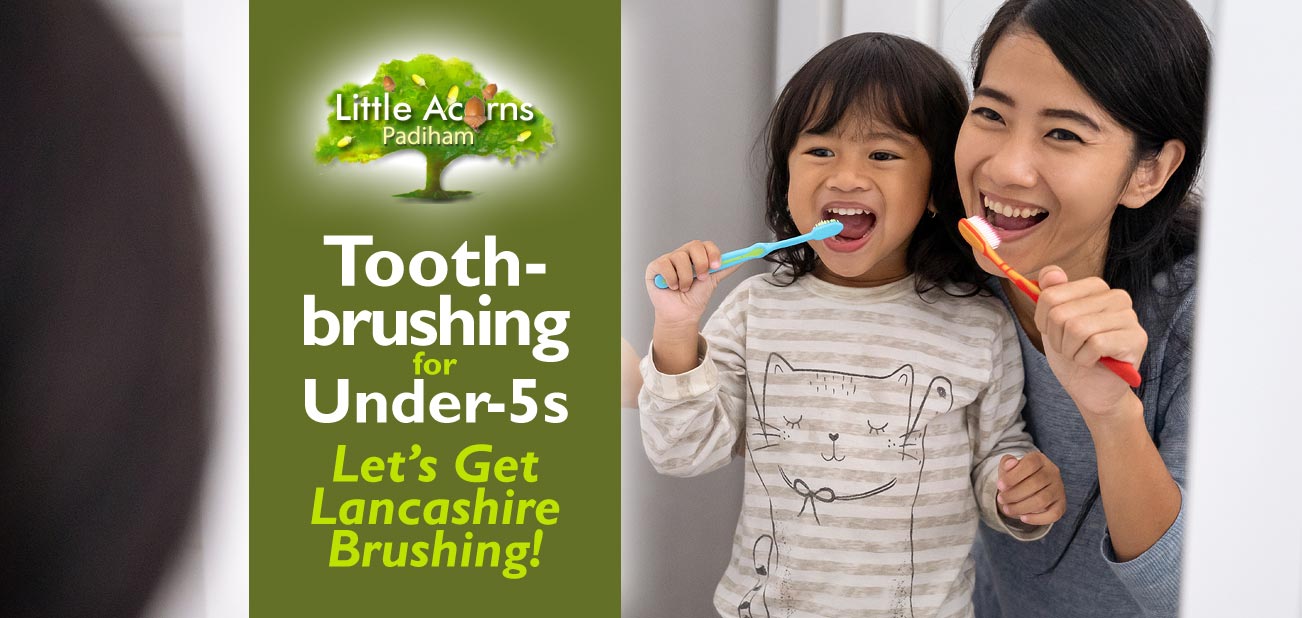
 Today we bring you a guide to toothbrushing for under-fives, inspired by children at Little Acorns Nursery taking part in Lancashire’s Let’s Get Lancashire Brushing campaign. An initiative of Lancashire County Council Public Health, the programme is designed to educate and encourage young children, including toddlers, to brush teeth for 2 minutes twice a day using age-appropriate toothpaste. What’s more, their message is that it’s never too young to begin and can even start before the first tooth has surfaced. At Little Acorns Nursery, the programme is supervised by staff and is intended to take place in tandem with toothbrushing at home — it does not replace it. Nursery staff guide children to establish a positive and proactive routine around toothbrushing, to foster good habits around oral hygiene, and thereby minimise tooth decay and problems associated with it.
Today we bring you a guide to toothbrushing for under-fives, inspired by children at Little Acorns Nursery taking part in Lancashire’s Let’s Get Lancashire Brushing campaign. An initiative of Lancashire County Council Public Health, the programme is designed to educate and encourage young children, including toddlers, to brush teeth for 2 minutes twice a day using age-appropriate toothpaste. What’s more, their message is that it’s never too young to begin and can even start before the first tooth has surfaced. At Little Acorns Nursery, the programme is supervised by staff and is intended to take place in tandem with toothbrushing at home — it does not replace it. Nursery staff guide children to establish a positive and proactive routine around toothbrushing, to foster good habits around oral hygiene, and thereby minimise tooth decay and problems associated with it.
“Children who start brushing at a young age tend to have healthier teeth as they get older.”— Lancashire County Council Public Health.
As part of the “Let’s Get Lancashire Brushing” initiative:
- Children at Little Acorns have each received a free toothbrush (replaced every quarter), a toothbrush holder, toothpaste, a brushing timer set for 2 minutes, and interactive learning resources that will help encourage them to brush regularly and thoroughly;
- Children’s families have received information leaflets about the campaign along with a reusable toothbrushing chart. If needed, more can be requested from your local Family Hub, Lancashire’s Healthy Young People and Families Service∞ or via a family’s health visitor.
- Learn more about the Let’s Get Lancashire Brushing initiative here.
Little Acorns children have loved taking part in this scheme and the good news is that appropriate toothbrushing has already become embedded in their daily routine. This approach is a great way to encourage children to look after their teeth from an early age. That’s something that’s known to keep teeth, gums, and oral health in good order as children get older, thereby reducing the need for fillings and the prospect of losing teeth.
“Taking care of your children’s teeth is essential for them to eat, drink, smile, talk, sing – and even shout, as well as protecting them from tooth decay!”— Michael Green, cabinet member for Health & Wellbeing.
Quick Guide to Brushing Children’s Teeth
Children’s teeth should be brushed twice per day, including once in the evening before bedtime. Brush for 2 minutes each time and, where possible, encourage children to spit out excess toothpaste. This may not be possible, of course, for babies and the youngest children. There is no need to rinse. Some additional guidelines for brushing children’s teeth follow:
Babies
- The NHS recommends that you start brushing babies’ teeth as soon as one or more teeth have begun to appear.
- Use an infant’s toothbrush, a “finger brush”, or a piece of clean gauze wrapped around a clean finger.
- Use just a smear of toothpaste.
- Use children’s fluoride toothpaste containing a minimum of 1,000 parts per million (ppm) of fluoride, unless a qualified dentist recommends the use of family toothpaste containing 1,350ppm to 1,500ppm of fluoride. (Source: NHS).
Children 3 to 6 Years
- Brush under adult supervision.
- Use a pea-sized amount of toothpaste.
- As with babies, the NHS recommends the use of children’s fluoride toothpaste containing a minimum of 1,000ppm of fluoride, unless a qualified dentist recommends the use of family toothpaste containing 1,350ppm to 1,500ppm of fluoride.
- Encourage the child to spit out excess foam after brushing.
- Don’t rinse – the fluoride toothpaste will not work as well.
Children Aged 7 or More
- Children aged 7 or more should now be able to brush independently. However, they should be monitored to ensure they brush each time for the full 2 minutes.
- They should use a pea-sized amount of toothpaste on the brush.
- Children of this age should use a family toothpaste containing 1,350ppm to 1,500ppm of fluoride.
- The child should spit out excess foam after brushing but, as with younger children, not rinse.
Supervising
 When brushing a baby or infant’s teeth, one of the best approaches is to sit them on your knee (taller/older children can stand), in front of a mirror so that you can both see their reflection. Tilt their head slightly backwards onto your chest and face them away from you towards the mirror. In this way, they can see how you are brushing their teeth and learn from your example. Small circular movements on their teeth and gums are a good way to start when they’re very young. Ensure all areas of their teeth and adjacent gums are brushed. By using the mirror approach, they will see how best to brush teeth and pick up the idea as they grow older. Once they learn to brush teeth independently, however, ensure you continue to supervise them. In this way, you can ensure that they remain thorough and spend a minimum of 2 minutes brushing each time. Guide children’s hands if they need help. An egg timer is useful as a reminder and may also be used to inject a bit of fun into the activity.
When brushing a baby or infant’s teeth, one of the best approaches is to sit them on your knee (taller/older children can stand), in front of a mirror so that you can both see their reflection. Tilt their head slightly backwards onto your chest and face them away from you towards the mirror. In this way, they can see how you are brushing their teeth and learn from your example. Small circular movements on their teeth and gums are a good way to start when they’re very young. Ensure all areas of their teeth and adjacent gums are brushed. By using the mirror approach, they will see how best to brush teeth and pick up the idea as they grow older. Once they learn to brush teeth independently, however, ensure you continue to supervise them. In this way, you can ensure that they remain thorough and spend a minimum of 2 minutes brushing each time. Guide children’s hands if they need help. An egg timer is useful as a reminder and may also be used to inject a bit of fun into the activity.
Safety tip: Never let children run around when they’re brushing their teeth; it’s dangerous and they could potentially end up hurt.
Little Acorns Nursery, Padiham
 Please get in touch if you’d like to explore a possible nursery place for your child at Little Acorns Nursery in Padiham, Lancashire. As well as providing for Padiham families, we’re located conveniently close to those in Hapton, Rose Grove, Burnley, Altham, Huncoat, Read, Simonstone, Sabden, Higham and Wood End. We provide a first-class early years education and high-quality weekday childcare for families. We also support many of the free childcare schemes funded by the UK Government, making it much more affordable for Lancashire families.
Please get in touch if you’d like to explore a possible nursery place for your child at Little Acorns Nursery in Padiham, Lancashire. As well as providing for Padiham families, we’re located conveniently close to those in Hapton, Rose Grove, Burnley, Altham, Huncoat, Read, Simonstone, Sabden, Higham and Wood End. We provide a first-class early years education and high-quality weekday childcare for families. We also support many of the free childcare schemes funded by the UK Government, making it much more affordable for Lancashire families.
Interested in a nursery place for your child? Choose a button to start your child’s journey at Little Acorns Nursery:
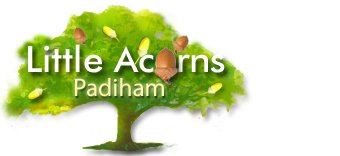



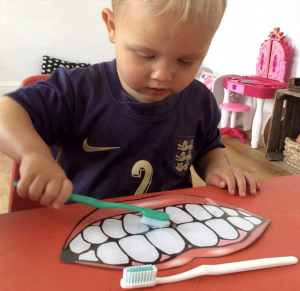

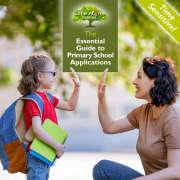

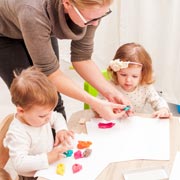 Primary school applications need to be submitted while the child is three or, at the very latest, has very recently had their fourth birthday. Because applications received on time are processed first, failure to apply by the due date means a child is less likely to receive an offer for their preferred school — places may no longer be available that late in the day.
Primary school applications need to be submitted while the child is three or, at the very latest, has very recently had their fourth birthday. Because applications received on time are processed first, failure to apply by the due date means a child is less likely to receive an offer for their preferred school — places may no longer be available that late in the day. Choosing a primary school for a child is an important step for any family. Somewhere conveniently close makes sense — and indeed is one of the most important criteria for offers, as we’ll see later. After all, you don’t want to be late dropping off or picking up your child because you’re stuck in a traffic jam miles away. Somewhere local will also mean your child has friends who are conveniently close by, which is another good thing. And, of course, if your child’s sibling already attends, then that school would usually be a natural first choice, assuming you’re happy with it of course.
Choosing a primary school for a child is an important step for any family. Somewhere conveniently close makes sense — and indeed is one of the most important criteria for offers, as we’ll see later. After all, you don’t want to be late dropping off or picking up your child because you’re stuck in a traffic jam miles away. Somewhere local will also mean your child has friends who are conveniently close by, which is another good thing. And, of course, if your child’s sibling already attends, then that school would usually be a natural first choice, assuming you’re happy with it of course. While the eligibility criteria for school places are not identical for all locations, there are several factors that are fairly standard. For example, schools closest to a child and those where a sibling already attends are usually favoured. Children may also be more likely to be accepted at a school where a parent has worked for 2 or more years. Church/faith schools are often also more likely to accept children who share the same faith.
While the eligibility criteria for school places are not identical for all locations, there are several factors that are fairly standard. For example, schools closest to a child and those where a sibling already attends are usually favoured. Children may also be more likely to be accepted at a school where a parent has worked for 2 or more years. Church/faith schools are often also more likely to accept children who share the same faith.  Primary school offers are first sent, by email, to those who applied on time and included a valid email address on their forms. Offers to such families are released on the morning of the 16th of April or the next working day if that happens to fall on a weekend or public holiday. Others who supplied an email address on their application, but who applied late in respect of the 15 January deadline, will usually receive offers via email the same day, although later on. Others, without an email address specified on applications, will receive offers via Second Class post, so are likely to see offers later than the 16th of April. Some local authorities, however, allow people to log onto a portal to view offers from that date. Note that those applying ‘in-year’ receive offers on different dates to the standard ones specified above.
Primary school offers are first sent, by email, to those who applied on time and included a valid email address on their forms. Offers to such families are released on the morning of the 16th of April or the next working day if that happens to fall on a weekend or public holiday. Others who supplied an email address on their application, but who applied late in respect of the 15 January deadline, will usually receive offers via email the same day, although later on. Others, without an email address specified on applications, will receive offers via Second Class post, so are likely to see offers later than the 16th of April. Some local authorities, however, allow people to log onto a portal to view offers from that date. Note that those applying ‘in-year’ receive offers on different dates to the standard ones specified above.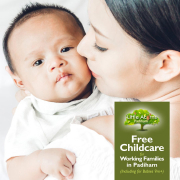

 Today, we remind Padiham families that Little Acorns Nursery supports the new — free — childcare scheme for eligible children including babies as young as just 9 months of age. Although it’s available only to eligible working families, the bar to entry is fairly low. The childcare funding is therefore attainable for many families. This free childcare is not just limited to babies either and, what’s more, it’s due to become even more generous from September 2025. In our guide below we’ll outline who is eligible, how much childcare funding they can access, how many childcare hours that equates to, and what the eligibility criteria are. If you’re the parent of a baby, toddler, or child up to three years old, this is for you.
Today, we remind Padiham families that Little Acorns Nursery supports the new — free — childcare scheme for eligible children including babies as young as just 9 months of age. Although it’s available only to eligible working families, the bar to entry is fairly low. The childcare funding is therefore attainable for many families. This free childcare is not just limited to babies either and, what’s more, it’s due to become even more generous from September 2025. In our guide below we’ll outline who is eligible, how much childcare funding they can access, how many childcare hours that equates to, and what the eligibility criteria are. If you’re the parent of a baby, toddler, or child up to three years old, this is for you. For those working families who are eligible, the scheme provides 570 hours per year of free childcare to children aged from 9 months to 3 years. This is normally taken as 15 hours per week for 38 weeks, usually aligning with the standard educational term-time weeks for school timetables. That said, it may be possible to stretch the hours over more weeks of the year if your childcare provider is able to accommodate such flexibility.
For those working families who are eligible, the scheme provides 570 hours per year of free childcare to children aged from 9 months to 3 years. This is normally taken as 15 hours per week for 38 weeks, usually aligning with the standard educational term-time weeks for school timetables. That said, it may be possible to stretch the hours over more weeks of the year if your childcare provider is able to accommodate such flexibility. We’ll try to simplify the eligibility criteria for you. Whether it’s for a baby aged 9 months, a toddler of 1 or 2, or a child aged 3 or 4, there are essentially four main criteria for this specific type of childcare funding:
We’ll try to simplify the eligibility criteria for you. Whether it’s for a baby aged 9 months, a toddler of 1 or 2, or a child aged 3 or 4, there are essentially four main criteria for this specific type of childcare funding: Well, it’s good news. It’s already the case that all 3 and 4-year-olds living in England are eligible to receive 570 hours (15 per week) of free childcare anyway. That’s available under what’s known as ‘Universal Entitlement’, a Government childcare funding scheme that’s been around for some time. What’s more, those working families that are eligible for the ‘new’ free childcare for children aged 9 months to 3 years are also likely to be eligible for a top-up of their child’s Universal Entitlement once they reach the ages of 3 and 4. In those cases, they’ll be entitled to 30 hours per week over 38 weeks (or however the 1140 free hours are spread out). That’s because the eligibility criteria are the same (see section above).
Well, it’s good news. It’s already the case that all 3 and 4-year-olds living in England are eligible to receive 570 hours (15 per week) of free childcare anyway. That’s available under what’s known as ‘Universal Entitlement’, a Government childcare funding scheme that’s been around for some time. What’s more, those working families that are eligible for the ‘new’ free childcare for children aged 9 months to 3 years are also likely to be eligible for a top-up of their child’s Universal Entitlement once they reach the ages of 3 and 4. In those cases, they’ll be entitled to 30 hours per week over 38 weeks (or however the 1140 free hours are spread out). That’s because the eligibility criteria are the same (see section above).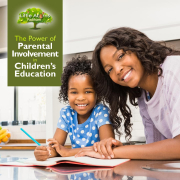
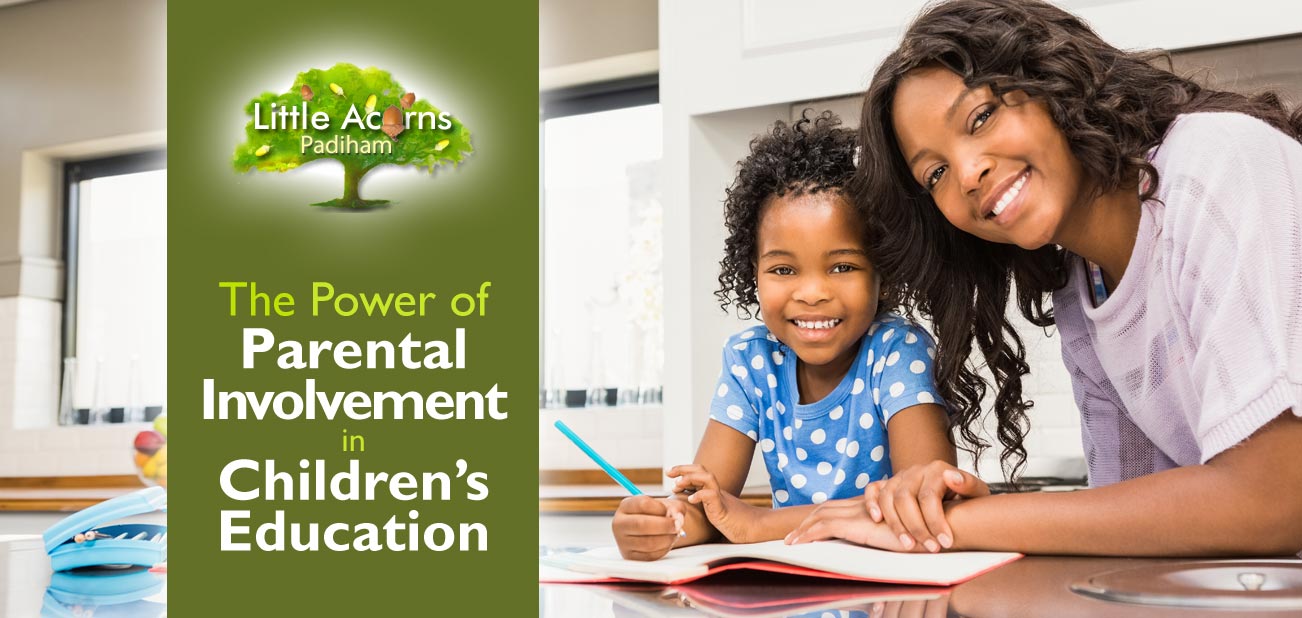
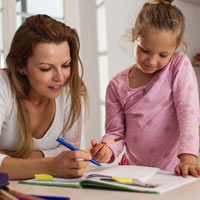 Parental involvement in a child’s education can take several forms. Note, however, that the benefits are most positive when parents engage right from the early years, beginning in children’s nursery and preschool years. The examples below show the kinds of parental involvement that will enhance children’s lives:
Parental involvement in a child’s education can take several forms. Note, however, that the benefits are most positive when parents engage right from the early years, beginning in children’s nursery and preschool years. The examples below show the kinds of parental involvement that will enhance children’s lives: Applying that information in the form of help and support while the child is at home. Referring to the right textbooks, helping with homework, and helping the child understand any tricky topics are typical examples of areas where parents can help children at home.
Applying that information in the form of help and support while the child is at home. Referring to the right textbooks, helping with homework, and helping the child understand any tricky topics are typical examples of areas where parents can help children at home. When children do well, praising them will encourage them to keep up the good work. It’ll give them a greater sense of achievement, and some moral support, and help instil a love for learning in them.
When children do well, praising them will encourage them to keep up the good work. It’ll give them a greater sense of achievement, and some moral support, and help instil a love for learning in them. Let’s now look at some of the benefits that children can expect to enjoy when parents are closely involved in their education.
Let’s now look at some of the benefits that children can expect to enjoy when parents are closely involved in their education. The benefits of parental involvement in education to children are numerous, though, also including the lowering of stress levels and improved knowledge, skills, outlook and outcomes. The deep and reliable source of support, together with all the other benefits, also combine to make children feel happier, have a higher quality of life, be less likely to skip lessons, be well-behaved, and have closer bonds with both parents and childcare/education staff.
The benefits of parental involvement in education to children are numerous, though, also including the lowering of stress levels and improved knowledge, skills, outlook and outcomes. The deep and reliable source of support, together with all the other benefits, also combine to make children feel happier, have a higher quality of life, be less likely to skip lessons, be well-behaved, and have closer bonds with both parents and childcare/education staff.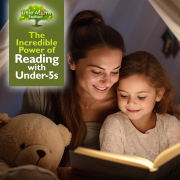

 Parents and caregivers have a simple yet incredibly powerful tool at their disposal to significantly boost the education of children under five: reading with them. In study after study, this simple activity has been shown to transform a child’s early years of education, giving children short-, medium-, and long-term benefits that even extend into adulthood. With that in mind, we take a look today at the many benefits and incredible power of reading with children, especially those under five.
Parents and caregivers have a simple yet incredibly powerful tool at their disposal to significantly boost the education of children under five: reading with them. In study after study, this simple activity has been shown to transform a child’s early years of education, giving children short-, medium-, and long-term benefits that even extend into adulthood. With that in mind, we take a look today at the many benefits and incredible power of reading with children, especially those under five. When you read to them, the cognitive benefits to children are profound and this is backed-up by findings from multiple studies. The benefits include improved memory, problem-solving, logical thinking, and memory skills. Even children’s attention spans are seen to improve when parents regularly read with them.
When you read to them, the cognitive benefits to children are profound and this is backed-up by findings from multiple studies. The benefits include improved memory, problem-solving, logical thinking, and memory skills. Even children’s attention spans are seen to improve when parents regularly read with them. One of the biggest winners when reading with children is the boost to their language skills. Indeed, a 4-decade study (
One of the biggest winners when reading with children is the boost to their language skills. Indeed, a 4-decade study ( If children are to get the most from reading, it’s important to read with them. That’s all about making it interactive, engaging and fun to ensure children are involved. There are a number of ways to accomplish this and doing so will be the key to them gaining the most benefit from the activity.
If children are to get the most from reading, it’s important to read with them. That’s all about making it interactive, engaging and fun to ensure children are involved. There are a number of ways to accomplish this and doing so will be the key to them gaining the most benefit from the activity.

 Calling all little citizen scientists — we need your help — and parents too! During part of July and early August the Big Butterfly Count takes place across the UK and the more children and families that take part, the better. All it needs to take is 15 minutes and taking part will help butterflies, daytime-flying moths and the conservation of nature and biodiversity in general. What’s more, it’s a free, enjoyable, educational, and hugely worthwhile activity for children and families to take part in. In today’s post, we’ll tell you everything you need to know in order to take part in 2024’s Big Butterfly Count. Little citizen scientists: get ready!
Calling all little citizen scientists — we need your help — and parents too! During part of July and early August the Big Butterfly Count takes place across the UK and the more children and families that take part, the better. All it needs to take is 15 minutes and taking part will help butterflies, daytime-flying moths and the conservation of nature and biodiversity in general. What’s more, it’s a free, enjoyable, educational, and hugely worthwhile activity for children and families to take part in. In today’s post, we’ll tell you everything you need to know in order to take part in 2024’s Big Butterfly Count. Little citizen scientists: get ready! You’ll need a tiny bit of preparation, but it’s quick, free, and easy…
You’ll need a tiny bit of preparation, but it’s quick, free, and easy…

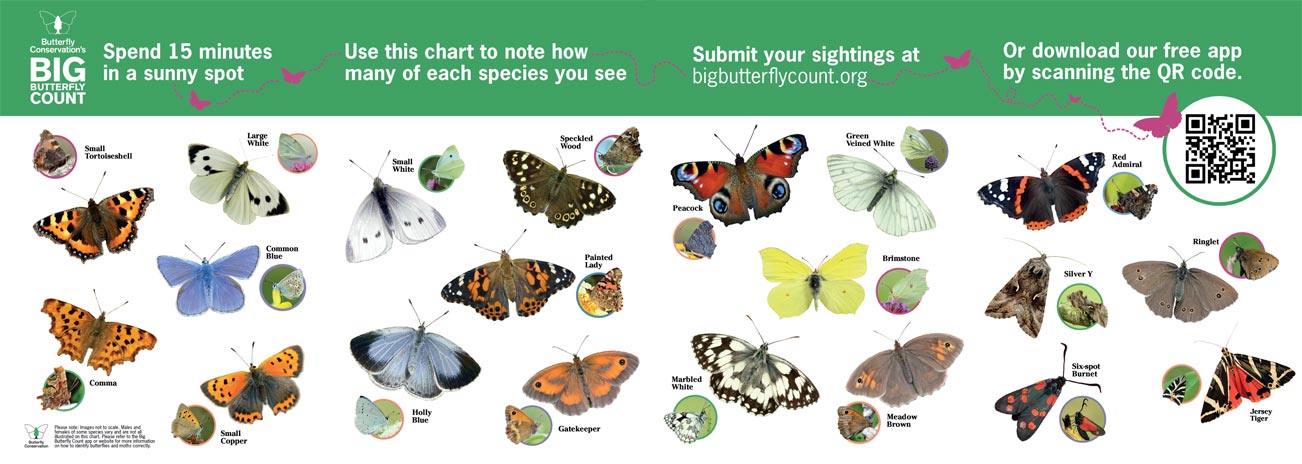
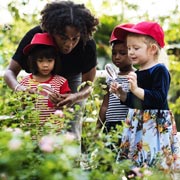 Once you’ve chosen a suitable location that has flowers blooming and is ideally sunny and sheltered, you are ready to count butterflies and submit them to the Big Butterfly Count survey.
Once you’ve chosen a suitable location that has flowers blooming and is ideally sunny and sheltered, you are ready to count butterflies and submit them to the Big Butterfly Count survey. In addition to taking part in the Big Butterfly Count, children and families can help butterflies in other simple ways too. What’s more, they’re also fun, educational, and make the world a better place. Additional ways to help butterflies – and other pollinators – include:
In addition to taking part in the Big Butterfly Count, children and families can help butterflies in other simple ways too. What’s more, they’re also fun, educational, and make the world a better place. Additional ways to help butterflies – and other pollinators – include: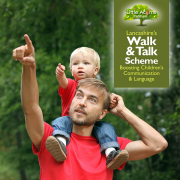
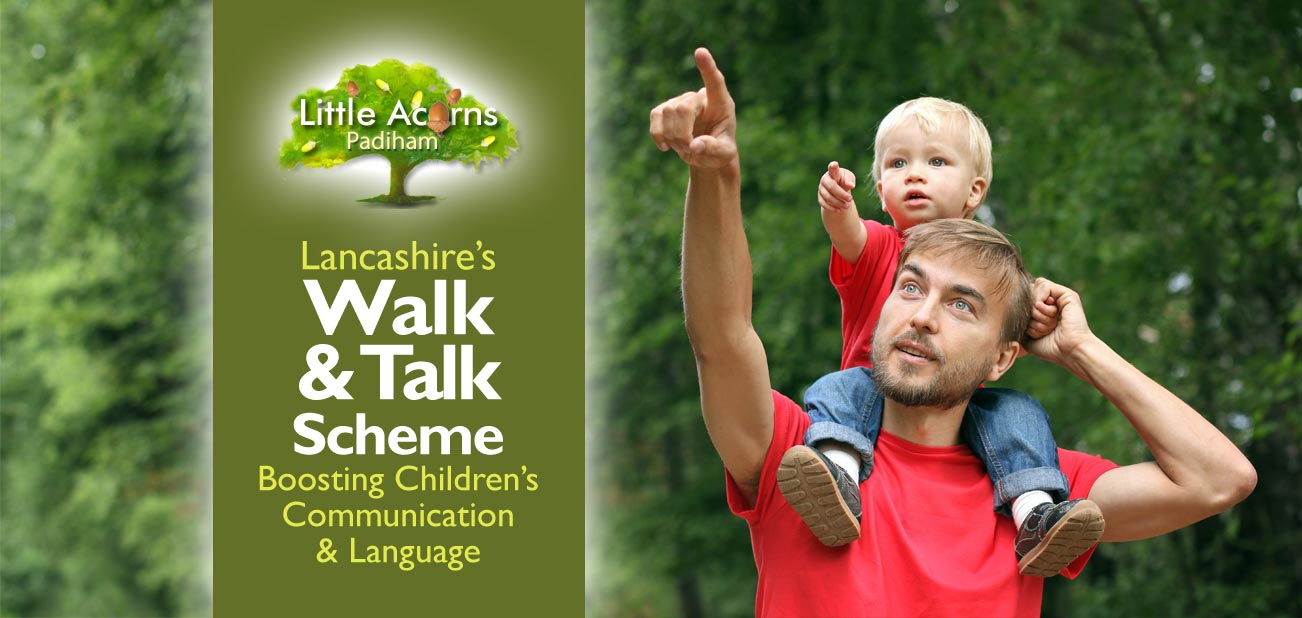
 Lancashire’s Walk & Talk Initiative is a scheme that’s wholeheartedly supported by the childcare practitioners at Little Acorns Nursery in Padiham. We encourage all Lancashire parents to take part too. It’s an initiative that is incredibly simple but has far-reaching benefits for children in their early years. Let’s take a look today at what Walk & Talk is all about, what its aims are, the benefits to children, and how families can get involved.
Lancashire’s Walk & Talk Initiative is a scheme that’s wholeheartedly supported by the childcare practitioners at Little Acorns Nursery in Padiham. We encourage all Lancashire parents to take part too. It’s an initiative that is incredibly simple but has far-reaching benefits for children in their early years. Let’s take a look today at what Walk & Talk is all about, what its aims are, the benefits to children, and how families can get involved.
 a reduction in the ‘word gap’ — helping children learn new words and widen vocabulary;
a reduction in the ‘word gap’ — helping children learn new words and widen vocabulary; The scheme also aims to encourage children to use a variety of senses. These include, for example, sight, smell, touch, taste, hearing and, of course, active listening. When out on walks there are so many different things for children’s senses to be stimulated by and each lends itself to a conversation. Whether it’s the sound of birdsong, the feeling of the wind on their faces, the smell of freshly-cut grass on the breeze, the noise of traffic, the dazzlingly beautiful colours of blossom, or the mouth-watering smell of food cooking around the neighbourhood or town, walking is indeed a feast for the senses.
The scheme also aims to encourage children to use a variety of senses. These include, for example, sight, smell, touch, taste, hearing and, of course, active listening. When out on walks there are so many different things for children’s senses to be stimulated by and each lends itself to a conversation. Whether it’s the sound of birdsong, the feeling of the wind on their faces, the smell of freshly-cut grass on the breeze, the noise of traffic, the dazzlingly beautiful colours of blossom, or the mouth-watering smell of food cooking around the neighbourhood or town, walking is indeed a feast for the senses.
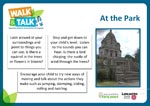

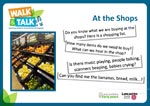
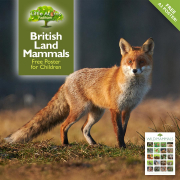




 Pyjamarama is a one-day fundraising event that’s organised through the children’s reading charity BookTrust. It takes place each year across a variety of UK settings including homes, schools, preschools, nurseries and more. As well as being great fun for those organising and taking part, the initiative is beneficial to millions of disadvantaged children. The ultimate aim is to raise money to fund the purchase of books and resources, so that every child in the UK gets the chance for bedtime stories and each family has proper reading opportunities. The initiative is hugely popular, great fun, and transforms lives. Today, we take a look at what to expect, how to get involved, and the many benefits of Pyjamarama.
Pyjamarama is a one-day fundraising event that’s organised through the children’s reading charity BookTrust. It takes place each year across a variety of UK settings including homes, schools, preschools, nurseries and more. As well as being great fun for those organising and taking part, the initiative is beneficial to millions of disadvantaged children. The ultimate aim is to raise money to fund the purchase of books and resources, so that every child in the UK gets the chance for bedtime stories and each family has proper reading opportunities. The initiative is hugely popular, great fun, and transforms lives. Today, we take a look at what to expect, how to get involved, and the many benefits of Pyjamarama. Pyjamarama is always a fun day for both adults and children. The added aspect of pyjamas makes it special, quirky and relaxed. And, at the end of the day, it’s incredibly worthwhile. Not only does it raise money to give disadvantaged children and their families opportunities for reading and bedtime stories, but it also encourages those children taking part in Pyjamarama to read more, for pleasure as much as anything. Additionally, it gives children a different perspective and encourages altruism and empathy for others less fortunate than themselves.
Pyjamarama is always a fun day for both adults and children. The added aspect of pyjamas makes it special, quirky and relaxed. And, at the end of the day, it’s incredibly worthwhile. Not only does it raise money to give disadvantaged children and their families opportunities for reading and bedtime stories, but it also encourages those children taking part in Pyjamarama to read more, for pleasure as much as anything. Additionally, it gives children a different perspective and encourages altruism and empathy for others less fortunate than themselves.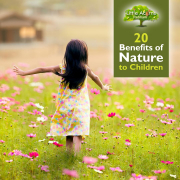
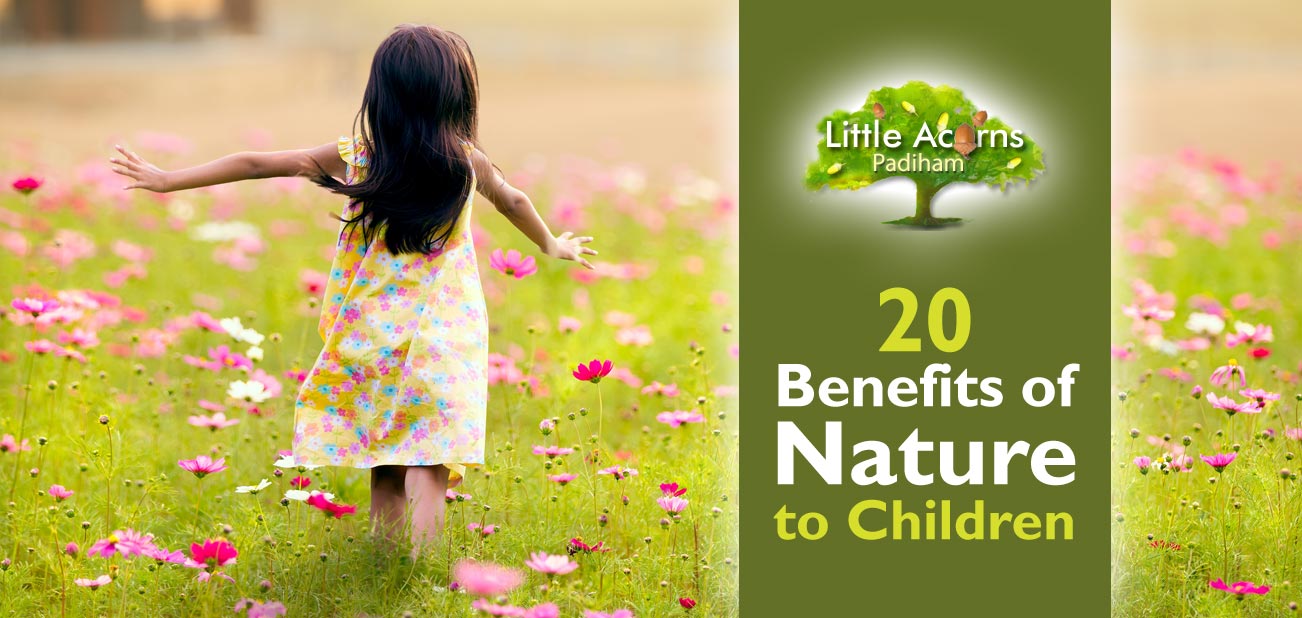
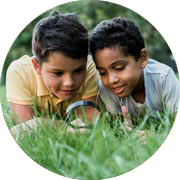 One of the many reasons we love nature and nature-based children’s activities here at Little Acorns Nursery is that nature is incredibly beneficial to children. What’s more, the benefits start right from their earliest years and are profoundly powerful to little ones. There have been many studies about this over the years and they all seem to conclude that nature is incredibly good for us all, especially so during the early years. Today’s post looks at 20 of the key benefits that spending time in and around nature holds for children and, with Spring now upon us, it’s the perfect time to begin getting little ones outside more, weather permitting.
One of the many reasons we love nature and nature-based children’s activities here at Little Acorns Nursery is that nature is incredibly beneficial to children. What’s more, the benefits start right from their earliest years and are profoundly powerful to little ones. There have been many studies about this over the years and they all seem to conclude that nature is incredibly good for us all, especially so during the early years. Today’s post looks at 20 of the key benefits that spending time in and around nature holds for children and, with Spring now upon us, it’s the perfect time to begin getting little ones outside more, weather permitting. Spending time in and around nature means children are more likely to be active, for example, walking, running, skipping, climbing, playing, making, or simply building a den. Such activities will not only help them hone fine and gross motor skills, but will also improve coordination, balance, and fitness. Those skills will help them day-to-day while expending energy in this way will help them maintain a healthy weight and body-mass index.
Spending time in and around nature means children are more likely to be active, for example, walking, running, skipping, climbing, playing, making, or simply building a den. Such activities will not only help them hone fine and gross motor skills, but will also improve coordination, balance, and fitness. Those skills will help them day-to-day while expending energy in this way will help them maintain a healthy weight and body-mass index. One of the more obvious benefits of nature is that it gives children a huge sense of freedom that they might not otherwise experience. Being in The Great Outdoors allows children, under appropriate supervision, to run, explore, and play in ways that are far more free than in any other situation. This will also give them a huge sense of natural joy.
One of the more obvious benefits of nature is that it gives children a huge sense of freedom that they might not otherwise experience. Being in The Great Outdoors allows children, under appropriate supervision, to run, explore, and play in ways that are far more free than in any other situation. This will also give them a huge sense of natural joy.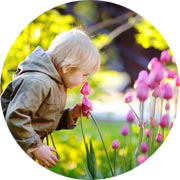 The stimulation of the senses is never more important than during children’s early years and spending time in nature is the perfect vehicle through which to do so. With so many colours, sounds, smells, textures and even (under adult supervision) tastes available in the natural world, it is indeed a feast for children’s senses. Through the senses, children will learn more about the world and generate millions of new connections in their developing brains. It’s almost magical!
The stimulation of the senses is never more important than during children’s early years and spending time in nature is the perfect vehicle through which to do so. With so many colours, sounds, smells, textures and even (under adult supervision) tastes available in the natural world, it is indeed a feast for children’s senses. Through the senses, children will learn more about the world and generate millions of new connections in their developing brains. It’s almost magical! Being around nature regularly can also help children lean naturally towards environmental issues, learn about the problems and become part of the solution. An appreciation of nature is indeed the first step towards becoming environmentally conscious and proactive. That’s a great thing for the planet, particularly as today’s children will become tomorrow’s custodians of the Earth.
Being around nature regularly can also help children lean naturally towards environmental issues, learn about the problems and become part of the solution. An appreciation of nature is indeed the first step towards becoming environmentally conscious and proactive. That’s a great thing for the planet, particularly as today’s children will become tomorrow’s custodians of the Earth. Children generally team up with friends when they’re playing and exploring outdoors. Spending time playing together in natural environments fosters many different kinds of interaction. This can boost confidence, language, communication and social skills. Stronger bonds and a deeper understanding of peers are likely to form from this.
Children generally team up with friends when they’re playing and exploring outdoors. Spending time playing together in natural environments fosters many different kinds of interaction. This can boost confidence, language, communication and social skills. Stronger bonds and a deeper understanding of peers are likely to form from this.